Tall, blonde, blue-eyed Curd Jürgens (1915-1982) played German soldiers in countless World War II films, usually billed as Curt Jurgens. Although the German-Austrian actor appeared in over 100 films, Jürgens considered himself primarily a stage actor. He also directed a few films, with limited success, and wrote screenplays.
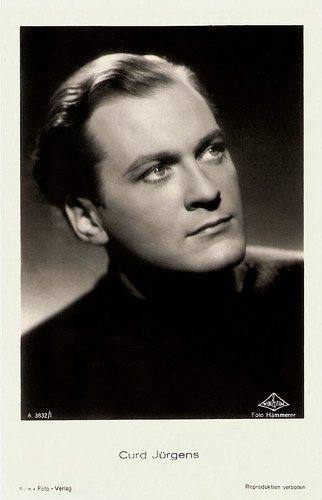
German postcard by Film-Foto-Verlag, no. A 3832/1, 1941-1944. Photo: Hämmerer / Wien Film.
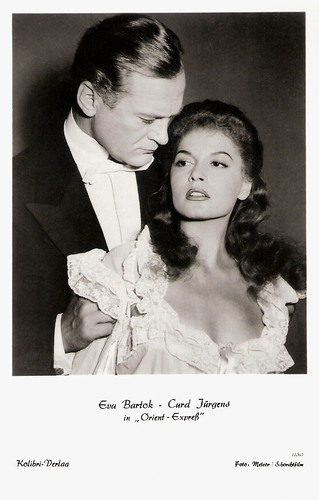
German postcard by Kolibri-Verlag, no. 1180. Photo: Meteor / Schorchtfilm. Still from Orient Express (Carlo Ludovico Bragaglia, 1954) with Eva Bartok.
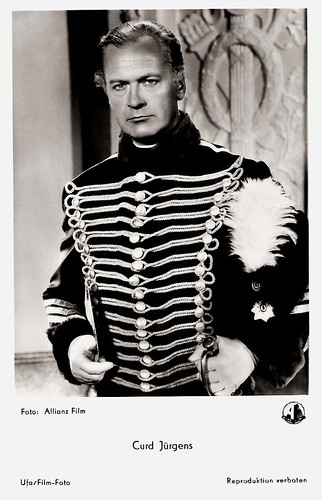
German postcard by Ufa, Berlin-Tempelhof, no. FK 3413. Photo: Allianz Film. Publicity still for Michel Strogoff/Michael Strogoff (Carmine Gallone, 1956).
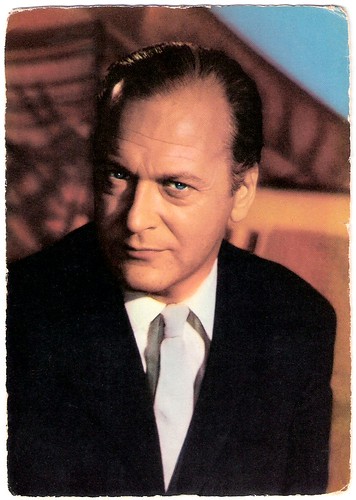
German postcard by ISV, no. C 1. Photo: Divina / Gloria / Grimm.

Vintage card.
Curd Gustav Andreas Gottlieb Franz Jürgens was born in Solln near München (Munich), Germany in 1915. His father was a trader from Hamburg and his mother was a French teacher. Since he wanted to become a writer, the eighteen-year-old Jürgens took a job as a reporter for the newspaper Acht-Uhr Abendblatt in Berlin. He married actress Lulu Basler after conducting an interview with her. She and her mother, Maria Solani, a former silent film star, encouraged the strikingly handsome young man to become a film actor.
His aristocratic bearing, his tall, stately appearance, and his talent for languages formed the foundation of his career. He learned his new profession on the Vienna stage, which retained his loyalty even after he became a global film star. He would become an ensemble member at the famous Vienna Burgtheater from 1940 to 1953 and from 1965 to 1968.
In 1933, he had a severe car accident. The medics had to cut his spermatic cords, which resulted in life-long infertility. His only child was, as later revealed by her mother, Eva Bartok, not his own. When he applied for a job at the UFA Studio in Neu-Babelsberg, he was discovered by Willi Forst, who hired him for the role of the young emperor Franz Joseph in Königswalzer/The King's Waltz (Herbert Maisch, 1935). The next year Jürgens starred in Familienparade/Family Parade (Fritz Wendhausen, 1936).
In 1937, he was cast opposite Swedish star Zarah Leander in Zu neuen Ufern/To New Shores (Detlev Sierck a.k.a. Douglas Sirk, 1937). The following years he appeared in films like Salonwagen E 417/Private Car E 417 (Paul Verhoeven, 1939) with Paul Hörbiger and Käthe von Nagy, Operette/Operetta (Willi Forst, 1940), Wen die Götter lieben/Whom the Gods Love (Karl Hartl, 1942) again as Emperor Josef II; and Frauen sind keine Engel/Women Are No Angels (Willi Forst, 1943) with Marte Harell.
Gradually increased his career status, but in 1944 Minister Joseph Goebbels sent him to a concentration camp for ‘political unreliables’, due to his anti-Nazi opinions. It was this experience in Nazi Germany that led him to become an Austrian citizen in 1945.
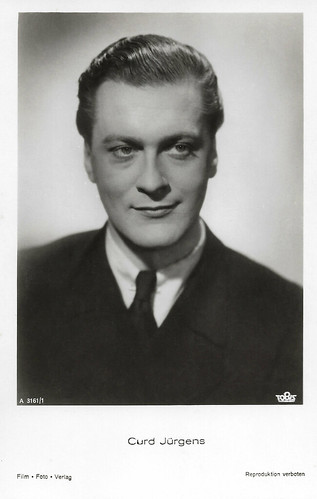
German postcard by Film-Foto-Verlag, no. A 3161/1, 1941-1944. Photo: Tobis.
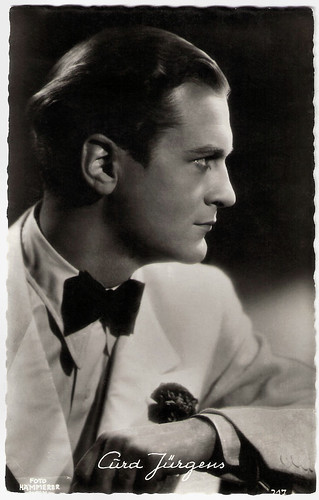
Austrian postcard by Verlag Hubmann, Wien (Vienna), no. 3323. Photo: Hämmerer, Wien.
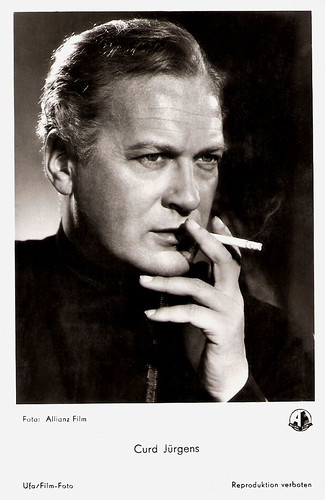
German postcard by Ufa/Film-Foto, Berlin-Tempelhof, no. FK 3412. Photo: Allianz Film.
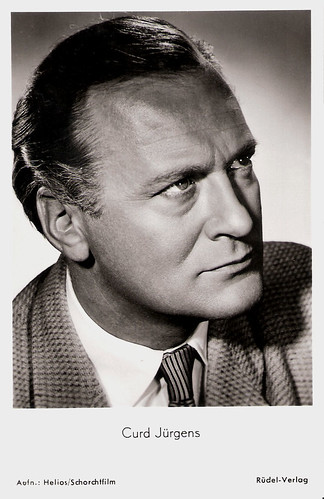
German postcard by Rüdel Verlag, Hamburg-Bergedorf, no. 567. Photo: Helies / Schorchtfilm. Publicity still for Musik bei Nacht/Music by Night (Kurt Hoffmann, 1952).
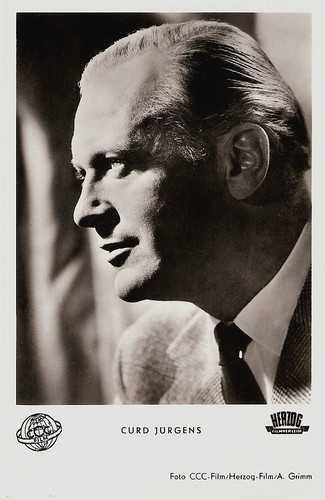
German postcard by Kunst und Bild, Berlin, no. I 409. Photo: CCC-Film / Herzog-Film / A. Grimm. Publicity still for Die Ratten/The Rats (Robert Siodmak, 1955).
After the war, Curd Jürgens continued to appear in German and Austrian films. His films included Das singende Haus/The Singing House (Franz Antel, 1948) with Hannelore Schroth, Der Engel mit der Posaune/The Angel with the Trumpet (Karl Hartl, 1948) with Paula Wessely, Hexen/Witches (Hans Schott-Schöbinger, 1949), Wiener Mädeln/Viennese Girls (Willi Forst, 1949), and Das Bekenntnis der Ina Kahr/The Confession of Ina Kahr (Georg Wilhelm Pabst, 1954) with Elisabeth Müller.
Jürgens co-authored with his friend Kurt Heuser the screenplay for Prämien auf den Tod/Premium on Death (1950) and he also directed the film. Jürgens wrote, directed, and starred in a second film as well, Gangsterpremiere (1951). The now cosmopolitan Jürgens exchanged Berlin and Vienna for the in-places of the beautiful and rich in St. Tropez, London, and Rome. His wealth, fame, love affairs, and parties made more headlines in the illustrated and scandal magazines than his films.
His breakthrough screen role came in 1955 with Des Teufels General/The Devil's General (Helmut Käutner, 1955), based on Carl Zuckmayer's play. Jürgens played the honourable pilot General Harras, who sells his soul to the devil because of his love for flying. That same year he won the Volpi Cup for Best Actor at the Venice Film Festival for Les Héros sont Fatigués/The Heroes Are Tired (Yves Ciampi, 1955). Then he appeared in the sensational French film Et Dieu... créa la femme/And God Created Woman (Roger Vadim, 1956) as Brigitte Bardot's older lover. BB nicknamed him ‘The Norman Hulk’.
Always interested in multilingual European actors with good looks and talent, Hollywood beckoned him. In 1957, he appeared in his first Hollywood film, The Enemy Below (Dick Powell, 1957), as a WW II U-boat commander in a duel with an American destroyer commander Robert Mitchum. Jürgens was subsequently the star of a well-intended but ill-fated remake of Der blaue Engel, The Blue Angel (Edward Dmytryk, 1959), taking on the role of the doomed teacher identified with Emil Jannings. He fared rather better-playing rocket scientist Werner Von Braun in the biographical film Wernher von Braun/I Aim at the Stars (J. Lee Thompson, 1959).
He went on to be a leading star of the European stage and international films. Onscreen he often played urbane villains including Cornelius, the cowardly and treacherous trading company representative, in Lord Jim (Richard Brooks, 1965), and sometimes a Nazi. A notable performance in this vein is the meditative officer in the epic The Longest Day (Ken Annakin, Andrew Marton, Bernhard Wicki, 1962), the most expensive black-and-white film ever made. One of his most famous roles was as the James Bond villain Karl Stromberg in The Spy Who Loved Me (Lewis Gilbert, 1977), arguably the best entry in Roger Moore's Bond series. Stromberg was a sociopathic industrialist seeking to transform the world into an ocean paradise.
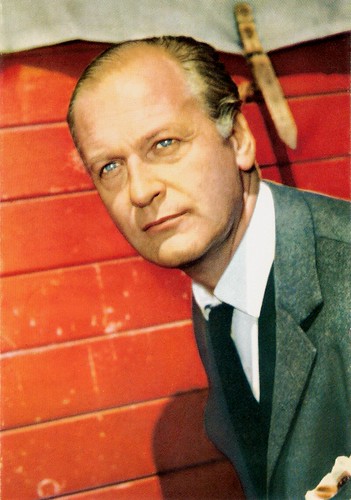
American postcard by East-West Publishers.
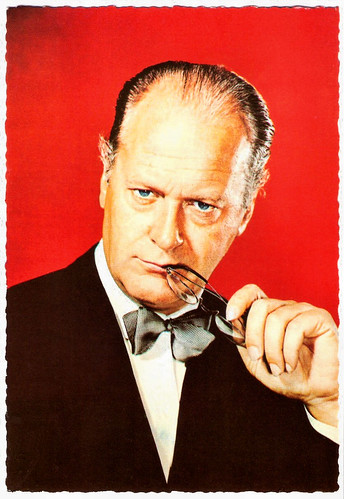
French postcard by E.D.U.G., no. 95.

German postcard by WS Druck, Wanne-Eickel, no. F 9. Photo: Ringpress.
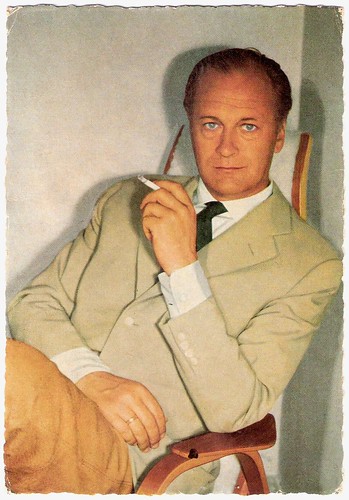
German postcard by WS-Druck, Wanne-Eickel, no. F 36. Photo: Ringpress.
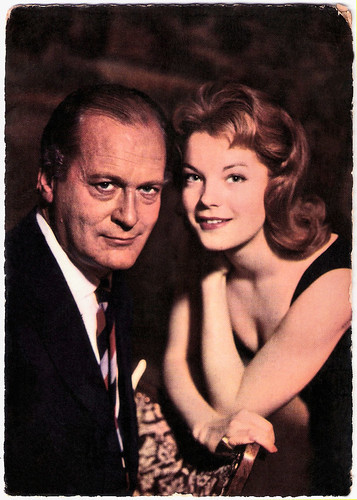
German postcard by ISV, no. 4. Photo: publicity still for Katia/Adorable Sinner (Robert Siodmak, 1959) with Romy Schneider.
Showing his sense of humour, Curd Jürgens titled his autobiography, '...und kein bißchen weise/Sixty and Not Yet Wise' (1976). He made his last stage appearance as Pasha Selim in 'The Abduction from Seraglio' during the Vienna State Opera's tour in Japan (1980).
His last film appearance was as Maître Legraine, beside Alain Delon and Claude Jade in the Soviet spy-thriller Tegeran 43/The Eliminator (Aleksandr Alov, Vladimir Naumov, 1981). His last TV role was as General Vladimir in the BBC miniseries Smiley's People (1982) based on the novel by John Le Carré and starring Alec Guinness.
In his wide and diverse acting career, Jürgens was nominated for two BAFTA's and was awarded the German Film Prize Filmband in Gold in 1959 and the Bundesverdienstkreuz (Cross of Merit of Germany) in 1981 for his outstanding contributions to German cinema.
Curd Jürgens maintained a home in France but frequently returned to Vienna to perform on stage and that was where he died of a heart attack in 1982. He was 66 years old. He had been hospitalised for the last two months. Friends said he had refused to reduce his activities despite years. Jürgens had suffered another heart attack several years before. During this, he had a near-death experience where he claimed he died and went to Hell.
Curd Jürgens was married five times: to actress Louise ‘Lulu’ Basler (1937-1947), Austrian actress Judith Holzmeister (1947-1955), actress Eva Bartok (1955-1957), Simone Bicheron(1958-1977), and Margie Schmitz (from 1978 till his death in 1982). He had one daughter, Deana, with Eva Bartok, but she was fathered by Frank Sinatra.

German postcard by Ufa/Film-Foto, Berlin-Tempelhof, no. FK 3916. Photo: Arthur Grimm.
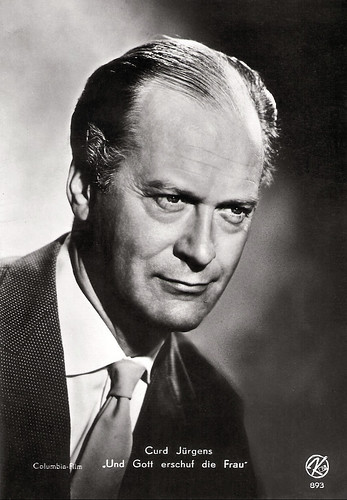
Austrian postcard by Kellner-Fotokarten, Wien (Vienna), no. 893. Photo: Columbia-Film. Publicity still for Et Dieu... créa la femme/...And God Created Woman (Roger Vadim, 1956).
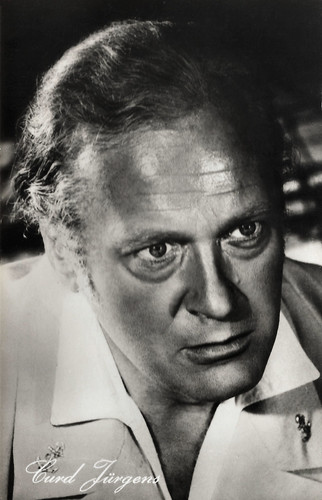
East-German postcard by VEB Progress Film-Vertrieb, Berlin no. 1339, 1960. Photo: publicity still for Tamango (John Berry, 1958).
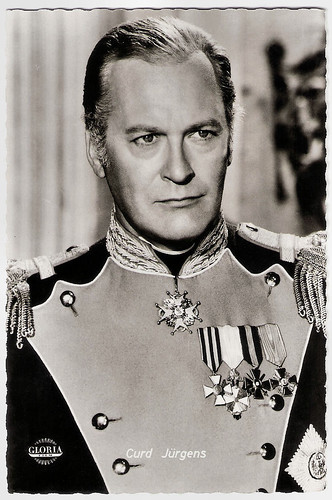
German postcard by Kolibri-Verlag G.m.b.H., Minden/Westf., no. 996. Photo: Speva / Gloria-Film. Publicity still for Katia/Adorable Sinner (Robert Siodmak, 1959).

German postcard by Ufa/Film-Foto, Berlin-Tempelhof, no. FK 4619. Photo: Ufa.
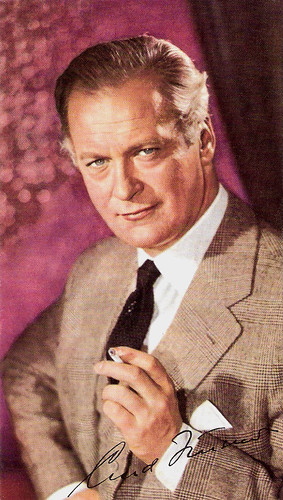
German collectors card by Lux.
Trailer for The Spy Who Loved Me (1977). Source: Movieclips Trailer Vault (YouTube).
Sources: Gertraud Steiner Daviau (Film Reference), T. Johnson (Find A Grave), Jon C. Hopwood (IMDb), AllMovie (Page now defunct), Wikipedia, and IMDb.
This post was last updated on 29 November 2024.

German postcard by Film-Foto-Verlag, no. A 3832/1, 1941-1944. Photo: Hämmerer / Wien Film.

German postcard by Kolibri-Verlag, no. 1180. Photo: Meteor / Schorchtfilm. Still from Orient Express (Carlo Ludovico Bragaglia, 1954) with Eva Bartok.

German postcard by Ufa, Berlin-Tempelhof, no. FK 3413. Photo: Allianz Film. Publicity still for Michel Strogoff/Michael Strogoff (Carmine Gallone, 1956).

German postcard by ISV, no. C 1. Photo: Divina / Gloria / Grimm.

Vintage card.
A strikingly handsome young man
Curd Gustav Andreas Gottlieb Franz Jürgens was born in Solln near München (Munich), Germany in 1915. His father was a trader from Hamburg and his mother was a French teacher. Since he wanted to become a writer, the eighteen-year-old Jürgens took a job as a reporter for the newspaper Acht-Uhr Abendblatt in Berlin. He married actress Lulu Basler after conducting an interview with her. She and her mother, Maria Solani, a former silent film star, encouraged the strikingly handsome young man to become a film actor.
His aristocratic bearing, his tall, stately appearance, and his talent for languages formed the foundation of his career. He learned his new profession on the Vienna stage, which retained his loyalty even after he became a global film star. He would become an ensemble member at the famous Vienna Burgtheater from 1940 to 1953 and from 1965 to 1968.
In 1933, he had a severe car accident. The medics had to cut his spermatic cords, which resulted in life-long infertility. His only child was, as later revealed by her mother, Eva Bartok, not his own. When he applied for a job at the UFA Studio in Neu-Babelsberg, he was discovered by Willi Forst, who hired him for the role of the young emperor Franz Joseph in Königswalzer/The King's Waltz (Herbert Maisch, 1935). The next year Jürgens starred in Familienparade/Family Parade (Fritz Wendhausen, 1936).
In 1937, he was cast opposite Swedish star Zarah Leander in Zu neuen Ufern/To New Shores (Detlev Sierck a.k.a. Douglas Sirk, 1937). The following years he appeared in films like Salonwagen E 417/Private Car E 417 (Paul Verhoeven, 1939) with Paul Hörbiger and Käthe von Nagy, Operette/Operetta (Willi Forst, 1940), Wen die Götter lieben/Whom the Gods Love (Karl Hartl, 1942) again as Emperor Josef II; and Frauen sind keine Engel/Women Are No Angels (Willi Forst, 1943) with Marte Harell.
Gradually increased his career status, but in 1944 Minister Joseph Goebbels sent him to a concentration camp for ‘political unreliables’, due to his anti-Nazi opinions. It was this experience in Nazi Germany that led him to become an Austrian citizen in 1945.

German postcard by Film-Foto-Verlag, no. A 3161/1, 1941-1944. Photo: Tobis.

Austrian postcard by Verlag Hubmann, Wien (Vienna), no. 3323. Photo: Hämmerer, Wien.

German postcard by Ufa/Film-Foto, Berlin-Tempelhof, no. FK 3412. Photo: Allianz Film.

German postcard by Rüdel Verlag, Hamburg-Bergedorf, no. 567. Photo: Helies / Schorchtfilm. Publicity still for Musik bei Nacht/Music by Night (Kurt Hoffmann, 1952).

German postcard by Kunst und Bild, Berlin, no. I 409. Photo: CCC-Film / Herzog-Film / A. Grimm. Publicity still for Die Ratten/The Rats (Robert Siodmak, 1955).
The Norman hulk
After the war, Curd Jürgens continued to appear in German and Austrian films. His films included Das singende Haus/The Singing House (Franz Antel, 1948) with Hannelore Schroth, Der Engel mit der Posaune/The Angel with the Trumpet (Karl Hartl, 1948) with Paula Wessely, Hexen/Witches (Hans Schott-Schöbinger, 1949), Wiener Mädeln/Viennese Girls (Willi Forst, 1949), and Das Bekenntnis der Ina Kahr/The Confession of Ina Kahr (Georg Wilhelm Pabst, 1954) with Elisabeth Müller.
Jürgens co-authored with his friend Kurt Heuser the screenplay for Prämien auf den Tod/Premium on Death (1950) and he also directed the film. Jürgens wrote, directed, and starred in a second film as well, Gangsterpremiere (1951). The now cosmopolitan Jürgens exchanged Berlin and Vienna for the in-places of the beautiful and rich in St. Tropez, London, and Rome. His wealth, fame, love affairs, and parties made more headlines in the illustrated and scandal magazines than his films.
His breakthrough screen role came in 1955 with Des Teufels General/The Devil's General (Helmut Käutner, 1955), based on Carl Zuckmayer's play. Jürgens played the honourable pilot General Harras, who sells his soul to the devil because of his love for flying. That same year he won the Volpi Cup for Best Actor at the Venice Film Festival for Les Héros sont Fatigués/The Heroes Are Tired (Yves Ciampi, 1955). Then he appeared in the sensational French film Et Dieu... créa la femme/And God Created Woman (Roger Vadim, 1956) as Brigitte Bardot's older lover. BB nicknamed him ‘The Norman Hulk’.
Always interested in multilingual European actors with good looks and talent, Hollywood beckoned him. In 1957, he appeared in his first Hollywood film, The Enemy Below (Dick Powell, 1957), as a WW II U-boat commander in a duel with an American destroyer commander Robert Mitchum. Jürgens was subsequently the star of a well-intended but ill-fated remake of Der blaue Engel, The Blue Angel (Edward Dmytryk, 1959), taking on the role of the doomed teacher identified with Emil Jannings. He fared rather better-playing rocket scientist Werner Von Braun in the biographical film Wernher von Braun/I Aim at the Stars (J. Lee Thompson, 1959).
He went on to be a leading star of the European stage and international films. Onscreen he often played urbane villains including Cornelius, the cowardly and treacherous trading company representative, in Lord Jim (Richard Brooks, 1965), and sometimes a Nazi. A notable performance in this vein is the meditative officer in the epic The Longest Day (Ken Annakin, Andrew Marton, Bernhard Wicki, 1962), the most expensive black-and-white film ever made. One of his most famous roles was as the James Bond villain Karl Stromberg in The Spy Who Loved Me (Lewis Gilbert, 1977), arguably the best entry in Roger Moore's Bond series. Stromberg was a sociopathic industrialist seeking to transform the world into an ocean paradise.

American postcard by East-West Publishers.

French postcard by E.D.U.G., no. 95.

German postcard by WS Druck, Wanne-Eickel, no. F 9. Photo: Ringpress.

German postcard by WS-Druck, Wanne-Eickel, no. F 36. Photo: Ringpress.

German postcard by ISV, no. 4. Photo: publicity still for Katia/Adorable Sinner (Robert Siodmak, 1959) with Romy Schneider.
Near-death experience
Showing his sense of humour, Curd Jürgens titled his autobiography, '...und kein bißchen weise/Sixty and Not Yet Wise' (1976). He made his last stage appearance as Pasha Selim in 'The Abduction from Seraglio' during the Vienna State Opera's tour in Japan (1980).
His last film appearance was as Maître Legraine, beside Alain Delon and Claude Jade in the Soviet spy-thriller Tegeran 43/The Eliminator (Aleksandr Alov, Vladimir Naumov, 1981). His last TV role was as General Vladimir in the BBC miniseries Smiley's People (1982) based on the novel by John Le Carré and starring Alec Guinness.
In his wide and diverse acting career, Jürgens was nominated for two BAFTA's and was awarded the German Film Prize Filmband in Gold in 1959 and the Bundesverdienstkreuz (Cross of Merit of Germany) in 1981 for his outstanding contributions to German cinema.
Curd Jürgens maintained a home in France but frequently returned to Vienna to perform on stage and that was where he died of a heart attack in 1982. He was 66 years old. He had been hospitalised for the last two months. Friends said he had refused to reduce his activities despite years. Jürgens had suffered another heart attack several years before. During this, he had a near-death experience where he claimed he died and went to Hell.
Curd Jürgens was married five times: to actress Louise ‘Lulu’ Basler (1937-1947), Austrian actress Judith Holzmeister (1947-1955), actress Eva Bartok (1955-1957), Simone Bicheron(1958-1977), and Margie Schmitz (from 1978 till his death in 1982). He had one daughter, Deana, with Eva Bartok, but she was fathered by Frank Sinatra.

German postcard by Ufa/Film-Foto, Berlin-Tempelhof, no. FK 3916. Photo: Arthur Grimm.

Austrian postcard by Kellner-Fotokarten, Wien (Vienna), no. 893. Photo: Columbia-Film. Publicity still for Et Dieu... créa la femme/...And God Created Woman (Roger Vadim, 1956).

East-German postcard by VEB Progress Film-Vertrieb, Berlin no. 1339, 1960. Photo: publicity still for Tamango (John Berry, 1958).

German postcard by Kolibri-Verlag G.m.b.H., Minden/Westf., no. 996. Photo: Speva / Gloria-Film. Publicity still for Katia/Adorable Sinner (Robert Siodmak, 1959).

German postcard by Ufa/Film-Foto, Berlin-Tempelhof, no. FK 4619. Photo: Ufa.

German collectors card by Lux.
Trailer for The Spy Who Loved Me (1977). Source: Movieclips Trailer Vault (YouTube).
Sources: Gertraud Steiner Daviau (Film Reference), T. Johnson (Find A Grave), Jon C. Hopwood (IMDb), AllMovie (Page now defunct), Wikipedia, and IMDb.
This post was last updated on 29 November 2024.
No comments:
Post a Comment